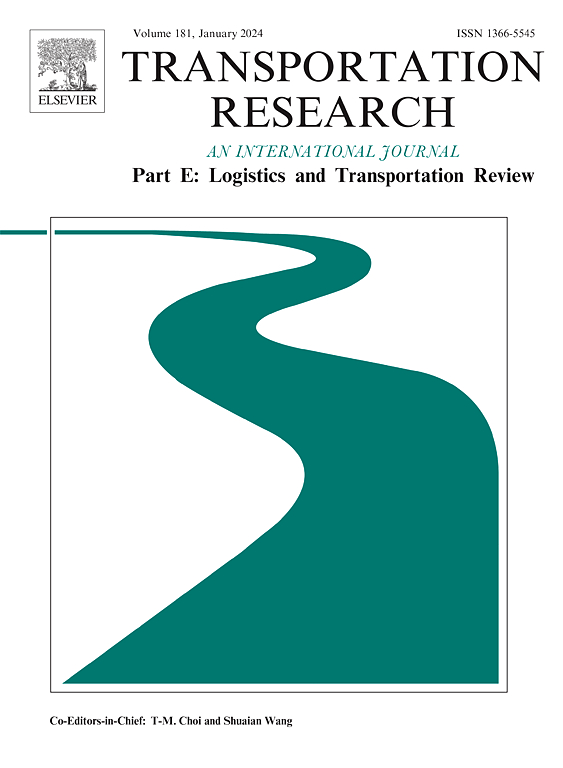港口数字化智能技术的最优质量设计:数字化协同下的博弈论方法
IF 8.8
1区 工程技术
Q1 ECONOMICS
Transportation Research Part E-Logistics and Transportation Review
Pub Date : 2025-10-04
DOI:10.1016/j.tre.2025.104459
引用次数: 0
摘要
智能港口通过创新技术和数据驱动解决方案提高运营效率。数字化过程中的一个关键战略决策是所采用的智能技术的质量水平。本文研究了业主港口模型框架下的最优质量设计,其中港口当局和码头运营商共同影响数字化转型。我们开发了三个博弈论模型来分析治理结构、数字化协同和转型不确定性如何影响质量和定价决策以及港口绩效。我们首先考察了利润最大化基础模型,发现两个利益相关者选择相同的质量水平来充分捕捉数字化协同效应。然后,我们研究了一个社会福利最大化模型,其中港务局作为一个社会规划师。我们发现,利益相关者都投资于更高质量的技术,而港务局相对于码头运营商过度投资,以提高社会福利。最后,我们扩展了基本模型,在传统服务和智能服务共存的过渡时期纳入了现实世界的不确定性。数值分析表明,在中高的转型不确定性下,港务局倾向于投资于更高的质量。然而,当过渡不确定性较低时,或者当强大的协同作用减轻了高不确定性带来的风险时,码头运营商会选择更高的质量水平。我们的研究结果强调了协同作用、公共治理和转型不确定性在港口数字化过程中的关键作用。本文章由计算机程序翻译,如有差异,请以英文原文为准。
Optimal quality design of smart technologies for port digitalization: A game theoretical approach under digitalization synergy
Smart ports improve operational efficiency through innovative technologies and data-driven solutions. A key strategic decision in the digitalization process is the quality level of smart technologies adopted. This paper examines optimal quality design under the landlord port model framework, where a port authority and a terminal operator jointly influence digital transformation. We develop three game-theoretic models to analyze how governance structures, digitalization synergy and transition uncertainties affect quality and pricing decisions as well as port performance. We first examine a profit-maximizing base model and find that both stakeholders choose the same quality level to fully capture digitalization synergy. We then investigate a social welfare–maximizing model, where the port authority acts as a social planner. We find that both stakeholders invest in higher quality technologies and the port authority overinvests relative to the terminal operator to enhance social welfare. We lastly extend the base model to incorporate real-world uncertainties through a transitional period, where traditional and smart services coexist. Numerical analysis shows that under moderate to high transition uncertainties, the port authority tends to invest in higher quality. However, when transition uncertainties are low, or when strong synergy mitigates the risks associated with high uncertainties, the terminal operator chooses higher quality level. Our findings highlight the critical role of synergy, public governance, and transition uncertainty in the port digitalization process.
求助全文
通过发布文献求助,成功后即可免费获取论文全文。
去求助
来源期刊
CiteScore
16.20
自引率
16.00%
发文量
285
审稿时长
62 days
期刊介绍:
Transportation Research Part E: Logistics and Transportation Review is a reputable journal that publishes high-quality articles covering a wide range of topics in the field of logistics and transportation research. The journal welcomes submissions on various subjects, including transport economics, transport infrastructure and investment appraisal, evaluation of public policies related to transportation, empirical and analytical studies of logistics management practices and performance, logistics and operations models, and logistics and supply chain management.
Part E aims to provide informative and well-researched articles that contribute to the understanding and advancement of the field. The content of the journal is complementary to other prestigious journals in transportation research, such as Transportation Research Part A: Policy and Practice, Part B: Methodological, Part C: Emerging Technologies, Part D: Transport and Environment, and Part F: Traffic Psychology and Behaviour. Together, these journals form a comprehensive and cohesive reference for current research in transportation science.

 求助内容:
求助内容: 应助结果提醒方式:
应助结果提醒方式:


